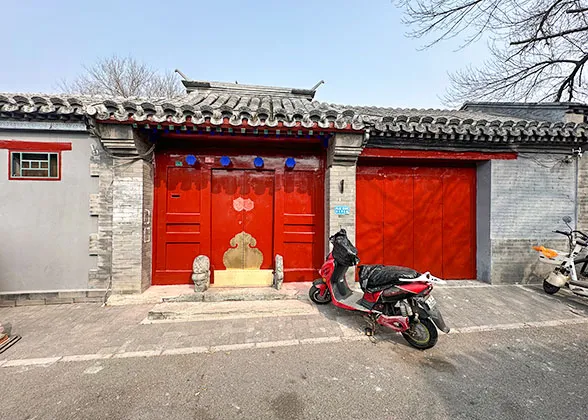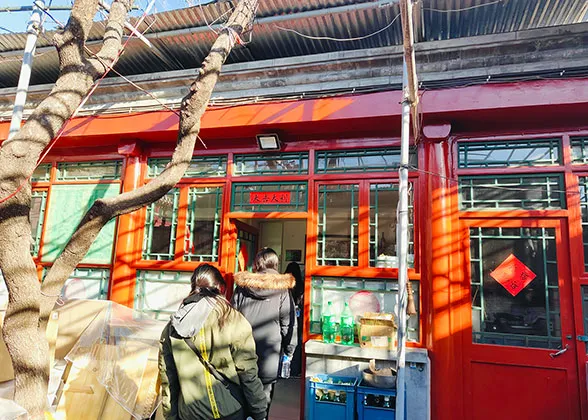Bada Hutong (Eight Great Hutongs)
Bada Hutong, also known as Eight Great Hutongs, once the synonym for the red-light district in Beijing, refers to an area in the city center to the west of Guanyin Temple and near the Dashilar Street outside the Qianmen Gate. The area features eight alleys from west to east named Baishun, Yanzhi, Hanjia, Shaanxi, Stone (Shitou), Zongshu Xiejie, Zhujia, and Xiaoli.
During the middle and late Qing Dynasty (1644 - 1911 AD), the eight alleys used to be the red-light district near the Forbidden City, attracting many officials. In that time, there were nearly hundreds of brothels, with many classy ones, distributed in the eight alleys. Nowadays, visitors can imagine the old days of Beijing through the well-preserved ancient brothel constructions, while wandering in the present residences and boutiques or staying in the traditional courtyard inns to meet the local people.
The layout of Bada Hutong is like a centipede with one trunk joining the other alleys together. The alleys are all connected with each other, so there are no dead ends. Most of the residents here are native Beijing people. They still live in the old courtyard together with different families, which is one feature of the old Beijing lifestyle. The living environment is very comfortable and simple.
Baishun Hutong is of 245 meters (804 feet) long and 5.7 meters (19 feet) wide. This alley was named Cypress (Baishu) in the Ming Dynasty (1368 – 1644 AD). Among the eight great alleys, this one is the most famous one, for there were two distinctive constructions built on it: Taiping Guild Hall and Jintai Guild Hall. Now, the two halls are transformed to ordinary courtyard dwellings.
Yanzhi Hutong joins the Baishun Hutong in the north. In the late Qing Dynasty, there were many cosmetics stores on the alley, so it was named Yanzhi, which in Chinese means rouge or blusher.
Parallel with Baishun Hutong to the north is Hanjia Hutong. A famous dramatist in the Qing Dynasty, Li Yu, lived in this alley. There used to be the bases of the Sanqingban, which is an opera troupe, and the Pear Garden Community. The culture of Chinese opera is very strong in this area.
Shaanxi Hutong (Shaanxi Xiang) is on the east of Baishun Hutong. It is 500 meters (1,640 feet) long. Two-storey black brick buildings are constructed along the alley. In the old time, the buildings were theaters, teahouses or brothels. But now, they serve as residences or hotels.
To the east of Shaanxi Hutong, lies an alley named Stone stretching from north to south. This alley has lasted for hundreds of years. It got its name because the building stones used to build the city wall in the Ming Dynasty were stored here.
The three alleys called Zongshu Xiejie, Zhujia and Xiaoli are connected with each other. The courtyards distributed in these alleys are very shabby. They were occupied by a group of lower class brothels in the old days. By subway
Take Subway Line 7, get off at Zhushikou Station, and get out from Exit A, then walk west; or get off at Hufangqiao Station, and get out from Exit A, then walk east.
By bus
1. Take Bus 5, 48, or 66 to Meishijie Nankou.
2. Take Bus 5, 23, 48, or 57 to Banzhanglu.
3. Take Bus 2, 20, 48, 59, 66, 93, 120, 622, Sightseeing Bus Line 1, Te 7, or Te 11 to Dashilar.
Beijing Bus/ Subway Search
During the middle and late Qing Dynasty (1644 - 1911 AD), the eight alleys used to be the red-light district near the Forbidden City, attracting many officials. In that time, there were nearly hundreds of brothels, with many classy ones, distributed in the eight alleys. Nowadays, visitors can imagine the old days of Beijing through the well-preserved ancient brothel constructions, while wandering in the present residences and boutiques or staying in the traditional courtyard inns to meet the local people.
|
|
The layout of Bada Hutong is like a centipede with one trunk joining the other alleys together. The alleys are all connected with each other, so there are no dead ends. Most of the residents here are native Beijing people. They still live in the old courtyard together with different families, which is one feature of the old Beijing lifestyle. The living environment is very comfortable and simple.
Baishun Hutong is of 245 meters (804 feet) long and 5.7 meters (19 feet) wide. This alley was named Cypress (Baishu) in the Ming Dynasty (1368 – 1644 AD). Among the eight great alleys, this one is the most famous one, for there were two distinctive constructions built on it: Taiping Guild Hall and Jintai Guild Hall. Now, the two halls are transformed to ordinary courtyard dwellings.
Yanzhi Hutong joins the Baishun Hutong in the north. In the late Qing Dynasty, there were many cosmetics stores on the alley, so it was named Yanzhi, which in Chinese means rouge or blusher.
Parallel with Baishun Hutong to the north is Hanjia Hutong. A famous dramatist in the Qing Dynasty, Li Yu, lived in this alley. There used to be the bases of the Sanqingban, which is an opera troupe, and the Pear Garden Community. The culture of Chinese opera is very strong in this area.
Shaanxi Hutong (Shaanxi Xiang) is on the east of Baishun Hutong. It is 500 meters (1,640 feet) long. Two-storey black brick buildings are constructed along the alley. In the old time, the buildings were theaters, teahouses or brothels. But now, they serve as residences or hotels.
To the east of Shaanxi Hutong, lies an alley named Stone stretching from north to south. This alley has lasted for hundreds of years. It got its name because the building stones used to build the city wall in the Ming Dynasty were stored here.
The three alleys called Zongshu Xiejie, Zhujia and Xiaoli are connected with each other. The courtyards distributed in these alleys are very shabby. They were occupied by a group of lower class brothels in the old days.
How to get to Bada Hutong
Take Subway Line 7, get off at Zhushikou Station, and get out from Exit A, then walk west; or get off at Hufangqiao Station, and get out from Exit A, then walk east.
By bus
1. Take Bus 5, 48, or 66 to Meishijie Nankou.
2. Take Bus 5, 23, 48, or 57 to Banzhanglu.
3. Take Bus 2, 20, 48, 59, 66, 93, 120, 622, Sightseeing Bus Line 1, Te 7, or Te 11 to Dashilar.
Beijing Bus/ Subway Search
| Admission Fee | Free |
|---|---|
| Opening Hours | All day |
- Last updated on Apr. 07, 2025 by Gabby Li -

